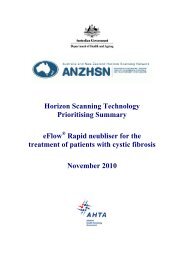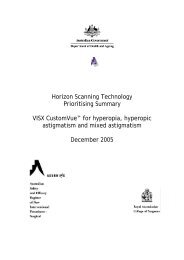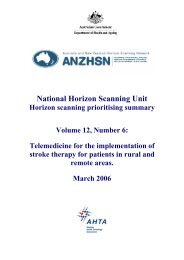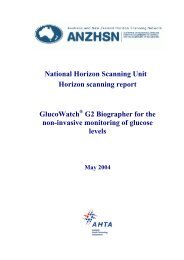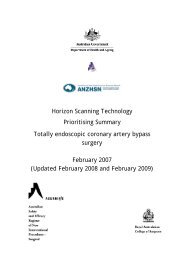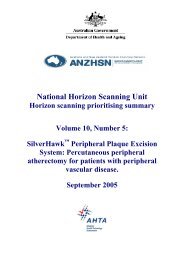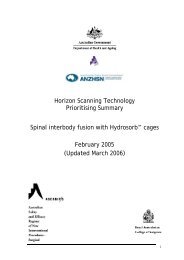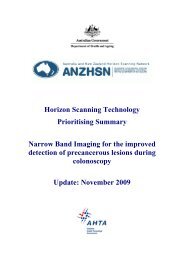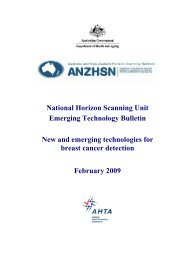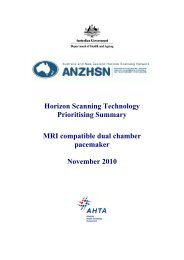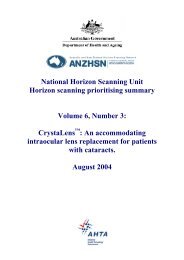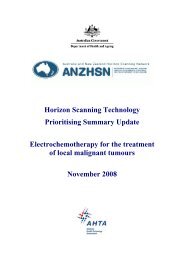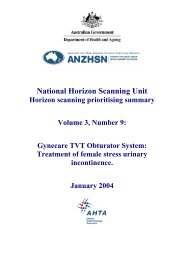Totally endoscopic coronary artery bypass surgery (Update)
Totally endoscopic coronary artery bypass surgery (Update)
Totally endoscopic coronary artery bypass surgery (Update)
You also want an ePaper? Increase the reach of your titles
YUMPU automatically turns print PDFs into web optimized ePapers that Google loves.
Horizon Scanning TechnologyPrioritising Summary<strong>Totally</strong> <strong>endoscopic</strong> <strong>coronary</strong> <strong>artery</strong> <strong>bypass</strong><strong>surgery</strong>February 2007(<strong>Update</strong>d February 2008)
© Commonwealth of Australia [2007]This work is copyright. You may download, display, print and reproduce this material inunaltered form only (retaining this notice) for your personal, non-commercial use or usewithin your organisation. Apart from any use as permitted under the Copyright Act 1968, allother rights are reserved. Requests and inquiries concerning reproduction and rights should beaddressed to Commonwealth Copyright Administration, Attorney General’s Department,Robert Garran Offices, National Circuit, Canberra ACT 2600 or posted athttp://www.ag.gov.au/ccaElectronic copies can be obtained from http://www.horizonscanning.gov.auEnquiries about the content of the report should be directed to:HealthPACT SecretariatDepartment of Health and AgeingMDP 106GPO Box 9848Canberra ACT 2606AUSTRALIADISCLAIMER: This report is based on information available at the time of research andcannot be expected to cover any developments arising from subsequent improvements tohealth technologies. This report is based on a limited literature search and is not a definitivestatement on the safety, effectiveness or cost-effectiveness of the health technology covered.The Commonwealth does not guarantee the accuracy, currency or completeness of theinformation in this report. This report is not intended to be used as medical advice and it is notintended to be used to diagnose, treat, cure or prevent any disease, nor should it be used fortherapeutic purposes or as a substitute for a health professional's advice. The Commonwealthdoes not accept any liability for any injury, loss or damage incurred by use of or reliance onthe information.The production of this Horizon scanning prioritising summary was overseen by the HealthPolicy Advisory Committee on Technology (HealthPACT), a sub-committee of the MedicalServices Advisory Committee (MSAC). HealthPACT comprises representatives from healthdepartments in all states and territories, the Australia and New Zealand governments; MSACand ASERNIP-S. The Australian Health Ministers’ Advisory Council (AHMAC) supportsHealthPACT through funding.This Horizon scanning prioritising summary was prepared by Mr. Irving Lee from theAustralian Safety and Efficacy Register of New Interventional Procedures – Surgical(ASERNIP-S).
PRIORITISING SUMMARYREGISTER ID:NAME OF TECHNOLOGY:PURPOSE AND TARGET GROUP:S000019TOTALLY ENDOSCOPIC CORONARY ARTERYBYPASS SURGERY (DA VINCI SYSTEM)PATIENTS SUFFERING FROM CORONARY ARTERYDISEASESTAGE OF DEVELOPMENT (IN AUSTRALIA): Yet to emerge Established Experimental Established but changed indicationor modification of technique Investigational Should be taken out of use Nearly establishedAUSTRALIAN THERAPEUTIC GOODS ADMINISTRATION APPROVAL Yes ARTG number N/A No Not applicableINTERNATIONAL UTILISATION:COUNTRYAustriaBelgiumCanadaDenmarkFranceGermanyIndiaItalyJapanNetherlandsRomaniaSaudi ArabiaSingaporeSwedenSwitzerlandUnited KingdomUnited StatesTrials Underway orCompletedLEVEL OF USELimited UseWidely Diffused
Figure 1: The da Vinci telemanipulation system© 2004 Intuitive SurgicalThe system is capable of providing high resolution 3D videoscopic images and allows remote,tremor-free and scaled control of <strong>endoscopic</strong> surgical instruments with 6 degrees of freedom(Mohr et al. 2001). The master console enables remote control of the <strong>endoscopic</strong> instrumentsmounted on a surgical cart with three (or four) robotic arms. The middle arm carries a stereoendoscope, while the left and right arms serve as endothoracic end effectors for remote tissuemanipulation using instruments that resemble the human wrist. The video image from thestereo endoscope is relayed to the master console as a 10x magnified 3D image whichprovides the surgeon with optimal visualisation of the surgical field (Dogan et al. 2002).CLINICAL NEED AND BURDEN OF DISEASECoronary <strong>artery</strong> disease (a.k.a. <strong>coronary</strong> heart disease) is the most common form of heartdisease in Australia. Based on the 2004-2005 National Health Survey, 1.7% of Australianssurveyed admitted to having manifestations of <strong>coronary</strong> <strong>artery</strong> disease. This corresponds toapproximately 334,500 Australians affected by this disease. The Australian Institute of Healthand Welfare reports that in 2003, there were approximately 49,800 <strong>coronary</strong> <strong>artery</strong> diseaseevents in Australia among 40 to 90 year olds. Less than 50% of these events were fatal(21,480 fatalities) and 86% of these deaths occurred outside of a hospital (AIHW 2006).Coronary <strong>artery</strong> disease presents a substantial burden to the healthcare system as it accountsfor 36% of all hospitalisations for cardiovascular disease in 2003 – 2004 (164,226hospitalisations for <strong>coronary</strong> <strong>artery</strong> disease). In addition to this, <strong>coronary</strong> <strong>artery</strong> disease hasbeen determined as the largest single cause of death in Australia in 2004, accounting for24,576 deaths, which equates to 19% of all deaths, and 51% of cardiovascular deaths (AIHW2006).DIFFUSIONThe da Vinci system is available in the Unites States, Europe, Asia and various other parts ofthe world. The Food and Drug Administration (FDA) in the United States cleared the da Vincisystem in 2000 for general laparoscopic procedures. Following this, the system was approvedfor prostatectomy, non-cardiac chest procedures and procedures involving surgical incisionsinto the heart (mitral valve repair). In 2004, the FDA expanded the application of the da Vincisystem to CABG. In Europe the da Vinci system has full regulatory clearance and is entitledto affix the CE mark to the system. In Australia, the da Vinci surgical robotic system is listedon the Therapeutic Goods Administration (TGA) Australian Register of Therapeutic Goods(ARTG) (Class IIb) and is distributed in Australia by Device Technologies Australia, P/L.
COMPARATORSAt the time of writing, there are no other robotic telemanipulator systems that are comparableto the da Vinci system. Previously, Computer Motion Inc. (California) manufactured the ZeusRobotic Surgical System which was similar to the da Vinci system. However, this system isno longer marketed and Computer Motion was bought by Intuitive Surgical in 2003 (FDA2005). The comparators to robotically assisted TECAB are:• Conventional CABG via open thoracotomy• MIDCAB• OPCAB (Off-pump <strong>coronary</strong> <strong>artery</strong> <strong>bypass</strong>)SAFETY AND EFFECTIVENESS ISSUESThe prospective FDA-sanctioned multicenter trial conducted by Argenziano et al. (2006)investigated the safety and efficacy of arrested/non-beating heart, single-vessel TECAButilising the da Vinci system in 98 patients requiring left anterior descending (LAD) <strong>coronary</strong><strong>artery</strong> revascularisation. The left internal mammary <strong>artery</strong> (LIMA) was harvested as the graftvessel. A total of 13 patients were excluded intraoperatively due to inability to establisheffective peripheral cannulation, deep intramyocardial <strong>coronary</strong> targets that could not bevisualised epicardially and dense pleuropericardial adhesions. Of the 85 patients undergoingTECAB, 5 patients (6%) required conversion to other techniques. One patient (1%) requiredreintervention of the target vessel on the first post-operative day due to graft occlusion. At 3-months follow-up angiography (n = 76), anastamotic occlusion was observed in 2 patientswhile significant anastomotic stenosis (≥ 50% occlusion) was noted in 4 patients. Overall,7/75 (9.3%) patients who underwent TECAB had either graft vessel reintervention orangiographic confirmation of graft failure; this corresponds to a freedom from graft failure of91%. The total operative time was 353 ± 89 minutes (mean ± SD) (range: 200 – 600 minutes)and the length of hospitalisation was 5.1 ± 3.4 days (range: 1.2 – 25.5 days). A total of 26patients (31%) required blood products perioperatively, this transfusion rate was higher thanexpected and may reflect the longer surgical times in some patients. No deaths were reportedthroughout the trial. However, the 4 cases of reinterventions and one case of perioperativemyocardial infarction results in 5 major adverse cardiac events in 85 patients (5.9%). Inaddition, there were 5 cases (5.9%) of groin infections as a result of the procedure(Argenziano et al. 2006).In another arrested heart TECAB case series study involving 45 patients with single- ordouble-vessel disease (37 single <strong>bypass</strong>es, 8 double <strong>bypass</strong>es), Dogan et al. (2002) reportedthat 11 patients (24.4%) required intraoperative conversion to either left-sidedminithoracotomy (n = 8) or median sternotomy (n = 3). The first 22 TECAB patients achieved100% patency before hospital discharge; however graft patency for the remaining 12 TECABpatients were not reported. Perioperative complications occurred in 1/34 patient (2.9%) whichrequired intraoperative exploration via median sternotomy due to haemodynamiccompromise. Postoperative complications were reported in 5 patients (14.7%). No woundinfections were observed at the port side; however one case of superficial wound infectionand one case of haematoma in the group was reported after femoral cannulation. The overallcomplication rates were higher compared to single-vessel MIDCAB. The investigatorsattributed this to the learning curve of performing TECAB due to the observation that most ofthe complications occurred within the first 20 patients of this study. In addition to the highercomplication rates, mean operating times for single-vessel (4.2 ± 0.9 hours) and double-vessel(6.3 ± 1.0 hours) TECAB in this case series was markedly longer compared to MIDCAB orconventional CABG (Dogan et al. 2002).
In the study by Mohr et al. (2001), a subgroup of the patient cohort (n = 35) underwentTECAB to anastomose the left internal thoracic <strong>artery</strong> to the left anterior descending <strong>artery</strong>.Of the 35 patients who received TECAB, 27 patients underwent the procedure with anarrested heart while the remaining 8 patients underwent the procedure with a beating heart.The investigators reported that 22/27 patients who were assigned to TECAB on the arrestedheart had completed the procedure. These patients had a conversion rate of 18.5%, 5/27patients (minithoracotomy or sternotomy). There was no patient mortality and all patientswere discharged with 100% patency. At 3 months, the patency rate was 95.4%, with only onecase requiring reoperation. As with other studies (Argenziano et al. 2006, Dogan et al. 2002),the investigators highlighted that there was a substantial learning curve associated with theprocedure, reflected by the long surgical durations ranging from 3.5 to 8 hours. A clear trendtowards shorter surgical times was observed as experienced with the procedure increased,however the overall time still exceeds that required of a standard MIDCAB approach.Meanwhile in patients assigned to undergo TECAB with a beating heart, only 4/8 completedthe procedure; 2 patients did not achieve adequate stabilisation while the other 2 patients hadcomplications related to the anastomosis. In the remaining 4 patients who underwent beatingheart TECAB, intraoperative angiography revealed 1 case of graft occlusion and one lowflowgraft in another patient; therefore both were converted to MIDCAB. In the remaining 2patients who completed the procedure, angiography revealed good runoff and widely patentanastomoses (50% initial patency rate, 2/4 patients) (Mohr et al. 2001).In the seminal study by Falk et al. (2000), the investigators reported on the use ofcomputer/robotic enhanced CABG in 66 patients, of these patients a subgroup of 22 patients(Group III in study) underwent arrested heart TECAB with the da Vinci system. During theprocedure, 4/22 patients (18%) were converted to other techniques due to various reasons. At3 months, all patients were free from angina and a 100% graft patency rate was achieved. Onepatient developed progressive dyspnoea 2-weeks postoperatively, and was diagnosed withpleural effusion and atelectasis of the lower left lobe which required multiple bronchoscopicinterventions. The operative time was 330 minutes (5.5 hours), ranging from 220 to 507minutes (Falk et al. 2000).One study examined if TECAB can be utilised in combination with catheter-basedinterventions. The retrospective review by Katz et al. (2006) examined a subpopulation ofpatients (n = 27) with multi-vessel disease from the larger trial by Argenziano et al. (2006)who received a hybrid approach of arrested heart TECAB (LIMA-LAD graft) coupled withpercutaneous <strong>coronary</strong> intervention (PCI) / stent placement of a second <strong>coronary</strong> <strong>artery</strong>. Thisstudy revealed that the use of the hybrid approach in the patient cohort resulted in noperioperative mortalities or neurological events. At 3-months follow-up, patient survival was100%. However a total of 8 patients (29.6%) required target vessel reintervention. Overall,the investigators concluded that TECAB for LIMA-LAD grafting can be combined withcatheter-based intervention to non-LAD targets in patients with multi-vessel disease.However, despite the low reintervention rates for the <strong>endoscopic</strong>ally placed graft (1/27patients, 3.7%), stent intervention rates were higher than expected (3/10 patients [30%] forbare metal stents; 4/17 patients [23.5%] for drug-eluting stents) in this cohort (Katz et al.2006).
statistically significant difference between the three groups. Safety in terms of theoccurrence of MACE at six months showed no statistically significant differencesbetween groups A and B, groups A and C, and groups B and C. Of the patients who didnot require a conversion, 9/164 (5%) had a MACE within the six month postoperativeperiod (four in group A and five in group B). Of the patients who required a conversion,3/64 (5%) reported a MACE. The perioperative safety of the procedure was determinedby comparing the performed procedures with open CABG safety data from the Society ofThoracic Surgeons (STS) National Database for isolated single vessel disease. Thisrevealed that perioperative MACE occurrence was similar between patients from thestudy (regardless of the group) and patients from the STS National Database. Mortality ingroup A and B occurred in one (1.1%) and two patients (2.2%), respectively with anadditional mortality in two patients from group C (2.1%). The mortality in group Aoccurred 10 months after <strong>surgery</strong> from immunosuppressive therapy complicationsfollowing kidney transplantation. In group B a patient scheduled for a hybrid proceduredied of acute infarction before the planned percutaneous intervention could be performed.The second patient died from major, acute gastrointestinal bleeding with shock andcardiac arrest leading to a coma after cardiopulmonary resuscitation. The overall mortalityrate for all three groups in the study was 2.1% compared with 2.4% for open CABG.Two patients (one in group A and B) had myocardial infarction within sevenpostoperative days (not statistically different to open CABG data), however this did notexceed the rate of myocardial infarction of CABG patients from the STS NationalDatabase. Overall, six patients underwent vessel reintervention within six months. Five ofthese underwent surgical reintervention while the sixth underwent stent placement. Therewas no statistically significant difference in the incidence of target vessel reintervention.Of the 100 long term follow-up (mean 3.5 years) patients, four had MACEs. This includedtwo patients which required percutaneous <strong>coronary</strong> intervention, one who sufferedmyocardial infarction and one death of an unknown cause (de Canniere et al. 2007).In a study conducted by Schachner et al. (2007), 85 patients (median age 58 years)underwent TECAB on an arrested heart using the da Vinci telemanipulator and remoteaccess perfusion through the femoral vessels by balloon endo-occlusion of the ascendingaorta and intermittent antegrade cardioplegia. Because cardiopulmonary <strong>bypass</strong> (CPB)and aortic endo-occlusion times are longer than conventional CABG techniques, thisstudy aimed to investigate the effect of increased surgical procedure time on myocardialenzyme levels and the postoperative course.Of the 85 patients undergoing TECAB, 13 (15.3%) required conversion to an openCABG. The mean duration of TECAB was 254 minutes (range: 178 minutes to 710minutes), 114 minutes (range: 57 minutes to 428 minutes) for CPB and 65 minutes (range:28 minutes to 230 minutes) for aortic endo-occlusion.Postoperatively, the myocardial enzyme concentration for all patients was measured uponarrival at the intensive care unit (ICU) and four, eight, 12, 32 and 36 hourspostoperatively. Forty-five per cent of patients had an increased peak creatine kinase MB(CK-MB) level greater than the 25 U/L cut off and 75% of patients had an increased peaktroponin T level greater than the 0.039 µg/L cut off. Postoperative peak CK-MB levelssignificantly increased with totally <strong>endoscopic</strong> <strong>coronary</strong> <strong>bypass</strong> grafting duration (r =0.588, p < 0.001), cardiopulmonary <strong>bypass</strong> time (r = 0.521, p < 0.001) and aortic endoocclusiontime (r = 0.400, p
statistically significant changes in the left ventricular ejection fraction as a result of the<strong>surgery</strong> (Schachner et al. 2007).In a study conducted by Bonatti et al. (2007) 10 patients (mean age 59 years), presentingwith either left main disease or left main equivalents, underwent totally <strong>endoscopic</strong>double-vessel <strong>coronary</strong> <strong>artery</strong> <strong>bypass</strong> grafting using the da Vinci system, remote-accessperfusion and aortic balloon endo-occulsion. In each patient <strong>endoscopic</strong> placement ofright IMA to the LAD in conjunction with left IMA grafting to an obtuse marginal (OM)branch was performed by a single surgeon. This procedure was successful in sevenpatients (70%). Three conversions to open CABG (via stermotomy) were required as aresult of intraoperative complications and to prevent major vascular injury. Thesecomplications included injury to the LIMA to OM graft by an <strong>endoscopic</strong> instrument aftersuccessful completion of <strong>bypass</strong> conduit, OM graft revision due to anastomotic stenosison the intraoperative angiographic control and an iliac <strong>artery</strong> level blockage of the RAPcannula advancement. There were no patient fatalities reported. Median ventilation timewas 15 hours, median ICU stay was 41 hours and median patient discharge time wasseven days post-op. The follow-up period ranged from one month to two years (medianfour months). During this time eight patients (80%) experienced no postoperativesymptoms. However, two patients reported chest pain not associated with myocardialischemia on stress tests. Other than these minor side effects, no major adverse cardiac orcerebrovascular episodes were observed throughout the entire observation period in anypatients (Bonatti et al. 2007).2008 HealthPACT ActionThe evidence regarding TECAB remains limited. Comparative clinical trials are requiredto compare TECAB with conventional CABG. These studies should ideally incorporatelonger follow up periods, the effect of surgeon experience on TECAB outcomes and theeffect of increased operation times on postoperative outcomes. Despite this, TECABappears to offer a potentially safer and less invasive alternative to CABG.This technology will therefore be monitored for 12 months.Number of Studies IncludedTotal number of studies 4Level III-2 intervention evidence 1Level IV intervention evidence 3ReferencesBonatti J, Schachner T, Bonaros N, Ohlinger A, Rutzler E, Feuchtner G, Kolbitsch C,Friedrich G, Bartel T,Pachingero and Laufer G. Robotic totally <strong>endoscopic</strong> double-vessel<strong>bypass</strong> grafting: A further step toward closed-chest surgical treatment of multivessel<strong>coronary</strong> <strong>artery</strong> disease. Heart Surgery Forum 2007; 10 (3): E239-E242.de Cannière D, Wimmer-Greinecker G, Cichon R, Gulielmos V, Van Praet F, Seshadri-Kreaden U and Falk V. Feasibility, safety, and efficacy of totally <strong>endoscopic</strong> <strong>coronary</strong><strong>artery</strong> <strong>bypass</strong> grafting: Multicenter European experience. Journal of Thoracic andCardiovascular Surgery 2007; 134 (3): 710-716.
Mishra YK, Wasir H, Sharma KK, Mehta Y and Trehan N. <strong>Totally</strong> <strong>endoscopic</strong> <strong>coronary</strong><strong>artery</strong> <strong>bypass</strong> <strong>surgery</strong>. Asian Cardiovascular and Thoracic Annals 2006; 14 (6): 447-451.Schachner T, Bonaros N, Ruetzler E, Weidinger F, Oehlinger A, Laufer G, Fredrich Gand Bonatti J. Myocardial enzyme release in totally <strong>endoscopic</strong> <strong>coronary</strong> <strong>artery</strong> <strong>bypass</strong>grafting on the arrested heart. Journal of Thoracic and Cardiovascular Surgery 2007;134 (4): 1006-1011.COST IMPACTThere are no cost-effectiveness studies on the use of the da Vinci system for TECAB. The daVinci system costs approximately USD$1,000,000 while specific instruments cost aboutUSD$1800 each (Wykypiel et al. 2003). The French CEDIT report estimated the costs likelyto be associated with the use of a da Vinci surgical robotic system for cardiac <strong>surgery</strong> in theFrench healthcare system; the results are presented in Table 1 (CEDIT 2003):Table 1: Estimated costs of robotic cardiac <strong>surgery</strong> in the French healthcare systemItem Cost estimate (€)Capital outlay (including warranty, shipping, installation, shipping) 1.1 – 1.2 millionmaintenance contract100,000 per yeartotal annual operating costs of already installed system 230,000first year operating costs (including purchase of new system)1.3 milliontotal annual additional cost incurred (annuity for depreciation,365,000operating costs including financial charges)The Medicare Benefits Schedule reimbursement fees for CABG are listed in Table 2:
Table 2: Medical Benefits Schedule of fees for capsule and conventional endoscopy (MedicareAustralia 2007)Category Item Number Benefit (AUD) Number of Claims (July2005 to June 2006)Coronary <strong>artery</strong> <strong>bypass</strong> with38497 $1809.30 524cardiopulmonary <strong>bypass</strong>, usingsaphenous vein graft or grafts only,including harvesting of vein graftmaterial where performedCoronary <strong>artery</strong> <strong>bypass</strong> with the aid 38498 $1809.30 15of tissue stabilisers, performedwithout cardiopulmonary <strong>bypass</strong>,using saphenous vein graft orgrafts only, including harvesting ofvein graft material whereperformed, either via a mediansternotomy or other minimallyinvasive technique and where astand-by perfusionist is presentCoronary <strong>artery</strong> <strong>bypass</strong> with38500 $1944.00 2390cardiopulmonary <strong>bypass</strong>, usingsingle arterial graft, with or withoutvein graft or grafts, includingharvesting of internal mammary<strong>artery</strong> or vein graft material whereperformedCoronary <strong>artery</strong> <strong>bypass</strong> with the aid 38501 $1944.00 244of tissue stabilisers, performedwithout cardiopulmonary <strong>bypass</strong>,using single arterial graft, with orwithout vein graft or grafts,including harvesting of internalmammary <strong>artery</strong> or vein graftmaterial where performed, eithervia a median sternotomy or otherminimally invasive technique andwhere a stand-by perfusionist ispresent,Coronary <strong>artery</strong> <strong>bypass</strong> with38503 $2110.75 2443cardiopulmonary <strong>bypass</strong>, using 2 ormore arterial grafts, with or withoutvein graft or grafts, includingharvesting of internal mammary<strong>artery</strong> or vein graft material whereperformedCoronary <strong>artery</strong> <strong>bypass</strong> with the aid 38504 $2110.75 190of tissue stabilisers, performedwithout cardiopulmonary <strong>bypass</strong>,using 2 or more arterial grafts, withor without vein graft or grafts,including harvesting of internalmammary <strong>artery</strong> or vein graftmaterial where performed, eithervia a median sternotomy or otherminimally invasive technique andwhere a stand-by perfusionist ispresentRe-operation of patient diseased<strong>coronary</strong> <strong>artery</strong> <strong>bypass</strong> vein graft orgrafts, dissection, disconnectionand oversewing of38637 $490.00 151
ETHICAL, CULTURAL OR RELIGIOUS CONSIDERATIONSNo issues were identified from the retrieved material.OTHER ISSUESSeveral authors in the study by Katz et al. (2006) are affiliated with Intuitive Surgical Inc., themanufacturer of the da Vinci system: Dr. Murphy and Dr. Srivastava are consultants forIntuitive Surgical Inc while Ms Kreaden is an employee of Intuitive Surgical.RECOMMENDATION:Based on the included studies, TECAB on the arrested heart with the da Vinci system can beperformed with acceptable safety and efficacy by surgeons who are appropriately/adequatelytrained with the equipment. Overall, the results of these studies compare reasonably withavailable data from studies of <strong>coronary</strong> <strong>bypass</strong> <strong>surgery</strong> by minimally invasive (MIDCAB) andconventional approaches. However, it should be noted that TECAB is associated withsubstantially longer surgical times, which may be of concern. At least one study hashighlighted increased perioperative transfusion rates (Argenziano et al. 2006) which may be adirect consequence of the longer procedural times.Despite attempts to perform TECAB on the beating heart, the success rate remains low (Mohret al. 2001). Therefore the benefits associated with beating heart TECAB, reduced trauma anddecreasing surgical time (no cannulation, reperfusion and rewarming required), remainsunattainable at this point time. Further studies are required to determine if the high costsassociated with the da Vinci system are justified and if the clinical benefits are substantialenough to justify the adoption of this technology at this stage. Based on the amount ofevidence available, HealthPACT recommends that the technology be monitored. Horizon Scanning Report Full Health Technology Assessment Monitor Archive Refer Decision pendingSOURCES OF FURTHER INFORMATION:Intuitive Surgical Inc. Last updated 2007. http://www.intuitivesurgical.com/index.aspx[Accessed January 2007].Falk V, Jacobs S, Gummert JF, Walther T, Mohr FW. Computer-enhanced <strong>endoscopic</strong><strong>coronary</strong> <strong>artery</strong> <strong>bypass</strong> grafting: the da Vinci experience. Seminars in Thoracic andCardiovascular Surgery 2003; 15(2): 104-111.LIST OF STUDIES INCLUDEDTotal number of studies 5Level IV intervention evidenceSEARCH CRITERIA TO BE USED:Coronary Artery Bypass/methods*Coronary Artery Bypass/instrmentationCoronary vessels/<strong>surgery</strong>Endoscopy/methods*Robotics*TECABTotal <strong>endoscopic</strong> <strong>coronary</strong> <strong>bypass</strong>da Vinci
REFERENCES:Australian Institute of Health and Welfare (AIHW): Coronary Heart Disease. Last updated2006. http://www.aihw.gov.au/cvd/majordiseases/<strong>coronary</strong>.cfm [Accessed December 2006].Argenziano M, Katz M, Bonatti J, Sricastava S, Murphy D, Poirier R, Loulmet D, Siwek L,Kreaden U, Ligon D. Results of the prospective multicenter trial of robotically assisted totally<strong>endoscopic</strong> <strong>coronary</strong> <strong>artery</strong> <strong>bypass</strong> grafting. Annals of Thoracic Surgery 2006; 81(5): 1666-1675.CEDIT. Robotic <strong>surgery</strong> using telemanipulators. Paris: Committee for Evaluation andDiffusion of Innovative Technologies - Assistance Publique Hôpitaux de Paris. Last updated2003. http://cedit.aphp.fr/english/f_pub_cedit_menu.html [Accessed January 2007].Dogan S, Aybek T, Andreβen E, Byhahn C, Mierdl S, Westphal K, Matheis G, Moritz A,Wimmer-Greinecker G. <strong>Totally</strong> <strong>endoscopic</strong> <strong>coronary</strong> <strong>artery</strong> <strong>bypass</strong> grafting oncardiopulmonary <strong>bypass</strong> with robotically enhanced telemanipulation: Report of forty-fivecases. Journal of Thoracic and Cardiovascular Surgery 2002; 123(6): 1125-1131.Falk V, Diegeler A, Walther T, Banusch J, Brucerius J, Raumans J, Autschbach R, Mohr FW.Total <strong>endoscopic</strong> computer enhanced <strong>coronary</strong> <strong>artery</strong> <strong>bypass</strong> grafting. European Journal ofCardio-thoracic Surgery 2000; 17(1): 38-45.FDA: Food and Drug Administration. Computer-assisted <strong>surgery</strong>: An update. Last updated2005. http://www.fda.gov/fdac/features/2005/405_computer.html [Accessed January 2007].Katz MR, Can Praet F, de Canniere D, Murphy D, Siwek L, Seshadri-Kreaden U, Friedrich G,Bonatti J. Integrated <strong>coronary</strong> revascularization: Percutaneous <strong>coronary</strong> intervention plusrobotic totally <strong>endoscopic</strong> <strong>coronary</strong> <strong>artery</strong> <strong>bypass</strong>. Circulation 2006; 114(1 Suppl): 473-476.Medicare Australia: Medicare benefits Schedule. Last update 2007.http://www9.health.gov.au/mbs/ [Accessed January 2007].Mohr FW, Falk V, Diegeler A, Walther T, Gummert JF, Bucerius J, Jacobs S, Autschbach R.Computer-enhanced “robotic” cardiac <strong>surgery</strong>: experience in 148 patients. Journal ofThoracic and Cardiovascular Surgery 2001; 121(5): 842-853.Wykypiel H, Wetscher GJ, Klaus A, Schmid T, Gadenstaetter M, Bodner J, Bodner E. Robotassistedlaparoscopic partial posterior fundoplication with the DaVinci system: initialexperiences and technical aspects. Langenbecks Archives of Surgery 2003; 387(11-12):411-416.



